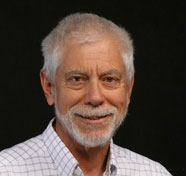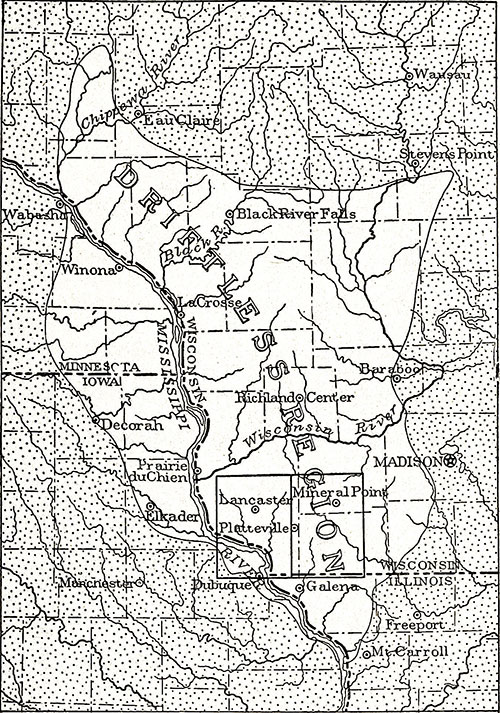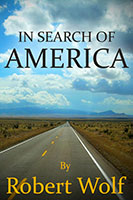

By Robert Wolf
Decorah, IA, USA

Robert Wolf
I live in rural northeast Iowa, in a portion of what is called the Driftless region. The Driftless is farm country, approximately the size of Massachusetts, and embraces portions of northeast Iowa, southeast Minnesota, southwest Wisconsin, and northwest Illinois. It is a land of rolling hills and winding valleys with alternating strips of corn and hay, or soybeans. If you stand atop a ridge, the surrounding valleys resemble a vast garden.
Attracted by the beauty of the land, I moved here with my wife in 1991. For months I did not see beneath the surface of life in the Driftless region, and when I did, I realized that the farm crisis of the 1980s was not over. I began to think about how such a region could escape the trauma of another national depression, and realized that only a region that was self-reliant and relatively self-sufficient could do this.
The Driftless region is in the process of realizing that dream of greater self-sufficiency. It is attracting young organic farmers and gardeners, artists and entrepreneurs as well as comfortable retirees. The newcomers are energetic and concerned about global warming and the use of chemical poisons in industrial farming. They want to help create a more cooperative society. You will often hear them use word "sustainable" and "sustainability," and their words are frequently matched by practice. My county, for example, has more solar installations per capita than any other in Iowa.
Like others of my acquaintance, I believe that our difficult and troubling times will only become more difficult and troubling. But like many of my acquaintances, I believe that if any rural region can survive the future in relative prosperity, our Driftless region has as good a chance as any. It certainly has a better chance than most. After all, we could produce all the food we need for a healthy diet, and steps are underway to create alternative banking models. Public and community development banks, even micro-lending circles, are being considered. Many of us here believe that repairing the present system is out of the question. A new society embracing different values and utilizing techniques that work with nature—not in opposition—must be born.
This point of view is a minority view among Driftless residents, albeit a growing minority. If the vision of a self-reliant and self-sufficient region is ever to be realized, more of the majority must be convinced that other ways of living and doing need to change. Cooperation must replace competition. Newcomers can and must be welcomed, not feared. Those who farm with chemicals need to understand that organic farming not only returns health to the soil but proves as profitable as industrial farming. Those who deny global warming but listen to reports of tornadoes and floods need to see that these natural disasters have a cause other than invention of liberal scientists and media.
When I first talked to people here about the need to create a regional economy, I encountered disbelief. When I explained that a strong regional economy would lessen the trauma of another national depression, people had no idea what I was talking about. They thought I was proposing isolation with no commerce between our region and the outside world.
The word "regionalism" was unknown to them. It has taken decades for the idea to spread and for increasing numbers of people here and elsewhere to agree that a regional economy is the only possible counter to centralization and globalism. If local economies cannot be developed and bonded together into a regional whole, then what will deliver prosperity?
For some the very idea of trying to build a vibrant economy within the Driftless region was insane, literally crazy. I came to understand that most people simply accepted that production and distribution was in the hands of giant entities beyond their control. Still, I kept writing and talking about the idea.
In 1994 I wrote a six-part editorial for Iowa Public Radio on the need to develop self-reliant regional rural economies. It won a national award, but not much attention beyond that. In this editorial series I was thinking primarily of the Driftless region. I thought that a common sense of place—a shared topography—would encourage Driftless residents to cooperate in creating a strong, self-reliant economy. I would help jumpstart the process by creating a regional survey—a regional portrait—for the quad-state area.
I wanted to create a portrait that would serve as a preliminary planning document that would be distributed free of charge across the Driftless area. I wanted people, lots of people, to begin talking about cooperative economic development. This survey would enable planners to understand the region's assets and needs, its demographics and natural systems, all of which they had to know before planning could begin.
I remembered Chuck Owen, a designer I had met in Chicago in my days as a journalist. Owen was the design theorist at the Institute of Design, a partial reincarnation of the Bauhaus within the Illinois Institute of Technology. Owen taught his students a design methodology that he had developed, and with his students had won numerous international awards. I reasoned that if this methodology could create floating airports, houses, vacuum cleaners and dirigibles, that it could be harnessed to create a regional economy. In order for residents to embrace the plan, they had to be involved in deciding which businesses, industries, and appropriate technologies were needed. Owen's method would be taught to everyday residents of the region, and under the supervision of Owen's graduate students, teams of residents would design the tools and instruments needed to create a self-reliant economy.

Early map of the Driftless region
Two northeast Iowa banks paid Owen's plane fare from Chicago, and I recruited about forty people to attend his talk in Lansing, Iowa, where he explained his method. Anarchist hippies, bankers, retailers, and farmers from Iowa and Wisconsin listened to Owen present his method. The anarchists didn't like anyone making strong arguments for anything (such a person must be authoritarian), the Decorah folks said they couldn't work with Lansing, and so on. I realized the futility of creating a survey for this quad-state area at that time. Bonding could only be achieved on a smaller scale, using sub-regional surveys of each portion of the states within the Driftless region, and then combining all into one.
The Northeast Iowa Book, funded by three Iowa colleges, was to be the first of the projected regional series, a tabloid with photographs, stories, and statistics accompanied by a survey of regional assets and needs, all created by students and adults, a real grassroots effort. The survey of assets and needs was to be the basis for the design team's work. The idea for the book had not only the support of three college presidents, but of area bankers and most high school principals. The leaders of the project saw the need. Selling it to area residents was another matter. There was doubt and outright hostility.
By the time the book was completed, I was too drained to inform the public of its purpose, let alone of its existence. The president of Northeast Iowa Community College and I threw the 5,000 copies of the tabloid book into the back of a college van and dumped them off at strategic points. Since there was no publicity and no public information meetings, nothing came of it. Few knew its purpose.
Even while the book was in its earliest stage, some were vehemently opposed to it. The most violent opposition came the evening I met with a dozen leaders of one town—a newspaper publisher, the high school principal, and local retailers—who, after I explained the contents of the proposed book, found every possible reason for opposing it.
The local publisher became hostile. "How was I going to distribute the book?" he asked. "You can't put it in mailboxes," he said, "that's against federal law. Who is going to distribute them? Were we planning on simply dumping them in grocery stores? How did we think people would learn about the book?"
He was energetically throwing up obstacles. Soon everyone else caught the spirit and they began arguing among themselves. I realized this group was not going to get involved and I was not going to waste more time explaining or justifying the project. I sat back and listened to them squabble for at least thirty or forty minutes before they decided to break up the meeting. During that time I said nothing. As we filed out of the room, an angry acquaintance from another town (who was friends with some of these people) whispered in my ear that this had been a complete waste of his time. Yet he was not going to talk this group back on track.
I was so exhausted by the effort of creating and trying to counter incomprehension and hostility that after the book was published I abandoned it. I saw then that the most fundamental issue to be addressed was the development of regional consciousness, that community development must precede economic development. Without a strong community of shared goals, growth is dictated by short-term, shortsighted policy, whether it springs from a developer's greed or the inadequate vision of town councils and county supervisors. Only coordinated grassroots efforts on a local and regional level can possibly reverse rural decline.
Clearly, achieving greater self-sufficiency is not simply a technical problem. More than anything, it is a social problem. Many people here, as elsewhere in America, believe that our centralized system is a reality of nature, like the Atlantic Ocean or the Adirondacks. It is here to stay; or if not, it is beyond our capacity to alter.
A friend of mine, the mayor of a town in the Driftless region, wrote to me, "There is a lot of ignorance in this world, including northeast Iowa. That doesn't mean these people lack basic intelligence, but they are insulated from the world of books and intelligent discussions. Their information comes from radio and TV and we know that most of that provides little in the way of high-level education.
"I had big plans for making changes [when I became mayor] but soon decided to slow down and work at accomplishing things that were needed and would receive support of the community. I have found out the hard way that you can't change local culture and ignorance overnight. It takes generations and sometimes I doubt that you can ever change it. However, I have had discussions with people who grew up and moved away from their 'hometown,' and after living elsewhere for many years come back and say, 'this place has really improved and joined the twenty-first century.'"
Rural people, including not only farmers but also small town residents, are conservative. They do not like change. An acquaintance who served as director of the Chamber of Commerce for another northeast Iowa town, said she quit in frustration after two years. New ideas proposed by some chamber board members were quashed by those who would say, "That was tried forty years ago and it didn't work then."
New arrivals account for the growing population of some towns. They offer hope, but residents whose roots go back generations regard them as outsiders, and often with hostility, since the newcomers frequently arrive with money and either purchase or build large homes. My friend the mayor wrote, "When we moved to town, long before becoming mayor, I was told you are either a part of the 'red neck tavern group' or the 'upper class elitists.' (They actually named the representative of both groups). If there is a middle group and one which is growing it is "the Friendly Tourists" or FT's ('f***ing tourists'), or outsiders, as they're called by some of the locals. Many of the outsiders buy up river property and increase property values. As mayor I have the respect of all groups and capitalized on this to minimize the division of groups, and with the council work towards betterment of the community."
Whether they are liked or not, the newcomers or "outsiders" provide much needed energy and a customer base for local businesses. So do those who grew up in the region but left for work and have now returned to retire. The out-migration of the young in search of work continues to leave the future of many towns in the hands of those whom the mayor described as "insulated from the world of books and intelligent discussions." But other towns within the region have had a sufficient influx of newcomers to revitalize their downtowns. The gun violence that has seized urban centers, along with the instability of financial and equity markets and the fear of terrorism, all have created a climate that is bound to lead people to seek a saner life.
Perhaps the greatest hope for developing a thriving economy for the Driftless region lies in attracting artists and entrepreneurs seeking a creative life amid a landscape that for beauty matches any in our country.
Links:
Robert Wolf
Free River Press
American Mosaic Radio with Robert Wolf





